新的无线局域网标准
With portable computers and wireless LANs, users can enjoy greater productivity while
away from their desks, whether they are in conference rooms, public areas or remote
offices.
Until recently, however, wireless LANs were too slow for most enterprise
applications.based on the IEEE 802.11 standdrd, they ran at 1M to 2M bit/sec.
Now a new high-rate extension to the standard, 802.11b, lets wireless networks
support data rates to 11M bit/sec.
Ratified in 1997, the original 802.11 standardunited the wireless industury by
defining a low-level protocol architecture that worked with conventional upper-layer
enterprise protocol stacks. Also, 802.11 maintained compatibility with the three most
popular radio transmission types: direct sequence spread spectrum, frequency-hopping
spread spectrum, and infrared.
Essentially, this new architecture added intelligence at the medium access control
(MAC)layer 2 and at the physical(PHY)layer 1, fosteing cooperation between the two
layers in performing the critical tasks involved with initiating and maintaining
wireless communi-cations.
For instance, to ensure reliability of the wireless link, MAC and PHY work together
to determine if a clear path exists before they start a transmission.
During transmission, they employ special collision-avoidance and
arrival-acknowledgment techniques that are not required in wired ethernet LANs.
�
In september 1999, the IEEE approved a new designation, known as 802.11.intended
to retain the error-correction,security, powermanagement and other advantages of the
original, a key ingredient-a thchnique for increasing bandwidth to 11M bit/sec.
Called complementary code keying(CCK)the technique works only in conjunction with
the DSSS technology sprcified in the original standard . it does net work with
frequency-hopping or infrared transmissions.
What CCK does is apply sophisticated mathematical formulas to the DSSS codes, a
permitting the code to represent a greater volume of informitter is now able to send
multiple bits of information with each DSSS code, enough to make possible the 11M bit
/sec in the original standard .
The 802.11b standard benefits users by delivering wireless ethernet speeds of 11M
bit/sec that can reliably support everyday business applications, e-mail, internet and
server network access.
With support from the new wireless ethernet from the new wireless ethernet
compatibility alliance, founded by 3com, lucent, nokia and several other companies in
the wireless LAN business, the new standard will also promise certified interoperability
across multivendor platforms.
Finally, the 802.11b standard serves as a clamoring for a simplified wireless LAN
landscpape.
�
Vendors can now focus on a single, high-speed standard, and users can cut through
the clutter of wireless options by fovusing on a standard that delivers multibvendor
interoperability and the performance to meet their application needs.
有了便携式和无线局域网,用户在离开其办公桌的时候,不管是在会议室、公共区域还是在
远处办公室,都能享有更高的生产效率。
然而,时至今日,无线局域网对多数企业应用来说还是太慢。依据 IEEE802.11 标准,他们
运行速度为 1 兆至 2 兆位/秒。
现在对此标准的一个新的更高速扩展,能让无线网支持高达 11 兆位/秒的数据速率。
最初的 802.11 标准是在 1997 年提出的,通过定义能与常规的上层企业协议组一起工作的低
级协议体系结构,把无线行业团结起来了。802.11 也保持了与三种最流行的无线电传输方式(直
接顺序扩频、跳频扩频和红外线)的兼容性。
本质上,这种新的体系结构在介质接入控制(MAC)层(第二层)和物理层(第一层)增加
了智能,建立这两层之间在执行及开始和保持无线通讯的关键任务时的协作关系。
例如:为确保无线连接的可靠性,MAC 层和物理层一起工作,以确定在他们开始传输之前是
否有一条清晰的路径。
在传输过程中,他们采用有线以太网不需要的、特殊的避免碰撞和到达应答技术。
1999 年 9 月,IEEE 批准了称作 802.11B 的新名称,作为 802.11 的高速扩展。此新的 802.11B
标准在保留原标准的纠错、安全、电源管理和其他优点的情况下,增加了一项关键内容,即把带
宽增加到 11 兆位/秒的技术。
�
此项技术叫做互补码键控(CCK),他只与原标准中规定的直接顺序扩频(DSSS)技术一起
工作,不能用跳频或红外线传输方式工作。
CCK 所做的工作是把复杂的数学公式应用于 DSSS 代码,以允许该代码在每个时钟周期表示
更多的信息。现在发射机能在每个 DSSS 代码中发送多个信息位,足以实现每秒 11 兆位/秒的数
据传输率,而不是原标准的 2 兆位/秒。
802.11B 标准给出 11 兆位/秒的无线以太网速度,给用户带来好处,速度能可靠地支持日常
的业务应用、电子邮件、因特网和服务器网络的接入。
由 3COM、LUCENT、NOKIA 和其他几家有无线局域网业务的公司组成的“无线以太网兼容性联
盟”支持新的标准,此标准也有望实现跨多厂商与用户团结起来的作用。
现在,厂商能专注在单一的高速标准上,用户也能以通过关注给出厂商互用性和性能。以满
足他们应用要求的标准上,解决了从一大堆无线网中作选择的难题。
了解到底什么是多媒体
The answer is neither simple nor easy. Multimedia is the combination of computer and
video technology. Multimedia really just two media sound and pictures, or in today's
term, audio and video. Multimedia itself has its binary aspects. As with all modern
technologies, it is made from a mix of hardware and software, machine and ideas. More
importantly, you can conceptually divide technology and function of multimedia into
control systems and information. The enabling force behind multimedia is digital
technology. Multimedia represents the convergence of digital control and digital
media---the PC as the digital control system and the digital media being today's most
�
advanced form of audio and video storage and transmission. In fact, some people see
multimedia simply as the marriage of PCs and video. PC power has reached a level close
to that needed for procession television and sound data streams in real time, multimedia
was born. Multimedia PC needs to be more powerful than mainstream computer---at least
the multimedia PC defines the mainstream. Among contemporary PCs, about the only things
that separate an ordinary computer from multimedia are a soundboard and a CD- ROM driver.
The CD serves as multimedia 's chief storage and exchange medium. Without the convenient
CD, the PC industry would lack a means of distributing the hundreds of megabytes of audio,
visual, and textual data that make up today's multimedia titles. Without CD, you couldn't
buy multimedia because publishers have no way of getting it to you.
So what is multimedia? By now you should agree that multimedia isn't any one thing
but a complex entity that involves the many things: hardware, software, and the interface
where they meet. But we've forgotten the most important thing that multimedia involves:
you. Yeah, sure. With multimedia, you don' t have to be a passive recipient. You can
control. You can interact. You can make it do what you want it to do. It means you can
tailor a multimedia presentation to your own needs. You can cut through the chaff and
dig directly into the important data in a report, pull together reports and video clips
from around the world that interest you. That's the strength of multimedia and what
distinguishes it from traditional media like books and television.
What does multimedia do? It presents information, shares ideas and elicits emotions.
It enables you to see, hear, and understand the thoughts of others. In other words, it
is a form of communication.
�
要回答这个问题不那么容易。多媒体是计算机和视频技术的结合,实际上它是两个媒体;声
音和图像,或者用现在的术语:音响和电视。多媒体本身有两个方面,和所有现代技术一样它是
由硬件和软件,或机器和思想混合组成。可以将多媒体技术和功能在概念上区分为控制系统和信
息。 多媒体之所以能够实现是依靠数字技术。多媒体代表数字控制和数字媒体的汇合,电脑是
数字控制系统,而数字媒体是当今音频和视频最先进的存储和传播形式。事实上有人就简单地认
为多媒体是电脑和电视的结合。电脑的能力达到实时处理电视和声音数据流的水平,这时多媒体
就诞生了。多媒体电脑需要具有比主流电脑更强的能力,多媒体电脑决定了主流电脑的发展。区
别普通电脑和多媒体电脑的主要东西是声卡和只读光盘驱动器。光盘是多媒体的主要存储和交换
媒体。没有这种方便的光盘,电脑工业就无法销售构成多媒体节目的几百兆字节的音频、可视的
和文字的数据,你也无法买到多媒体。
现在可以回答什么是多媒体。它不只是一件东西,而是包括许多东西的复杂的组合:硬件、
软件和这两者相遇时的界面。不,我们还忘了一件最重要的事情.多媒体还包括你。咳,就是!
对于多媒体,你不再是一个被动的观众,你可以控制,可以交互作用,可以让它按你的需要去做。
在一个报告中,你可以不管那些无用的东西而直接进入重要的数据,可以将感兴趣的全世界的报
告和图片收集汇编到一起。这就是多媒体的力量和它与传统媒体(如书本和电视)的区别所在。
多媒体能做什么?它展示信息、交流思想和抒发情感。它让你看到、听到和理解其他人的思
想。也就是说,它是一种通讯的方式。
Almost three years ago, cisco and microsoft annouced the directory enabled network
(DEN)initiative, which sought to develop a standard for storing information about
network devices, applications and users in a single directory.
This directory would bind a user's name and network resource access profile to
policies for granting or restricting that access, and delegating bandwidth priorities
�
and privileges.work on standardizing specifications for the directory were handed off
to the distributed manage-ment task force (DMTF).
In march, the DMTF announced it had completed work on a new version of the common
infor-mation model that facilitates the mapping of the CIM schema into a lightweight
directory access protocol(LDAP)-compliant directory. CIM defines how to represent
network device, system and application data in a directory so it can be easily shared
for DEN and enter-prise management purposes.
By mapping the CIM schema into an LDAP directory, users will be able to further
integrate directory information into an overall enterprise management system, the DMTF
says.
Customers will make DEN-compliant products a priority once the DMTF makes a little
more progress on DEN specifications-such as defining a pollicy schema that would specify
data structures for binding directory profiles to network security and
quality-of-service (QOS)policies and products soon follow.
Perhaps, vendors still have to determine how to use directories to prompt network
and applications to configure themselves based on business policies. For example, when
a user logs on to a network, the directroy would recognize the user's name, department,
location and rank within the company, and bind this information with the user's network
access or restriction policies. then the IT infrastructure would configure itself
accordingly to enable or disable that a access.
�
One of the killer applications for DEN when it was announced was the ability to link
QoS policies to users via dircetories. But bandwidth has become cheaper and more
plentiful in the LAN over the past two years, and that's made QOS much less of an issue.
Instead of prioritizing bandwidth allocation, users can inexpensively overprovision
band-width when they need to support delay-sensitive traffic such as voice and video.
Also, simple mechanisms such as setting 802.1p bits on ethernet frame or type-of -service
bits in IP headers are enough for LAN QOS.
Nonetheless, there 's still a huge demand among enterprise users for directories
to enable self-configuring networks based on business policy.
DEN for QOS may still apply for WAN applications, edholm says. Indeed cisco has made
more strides with DEN in the service provider market than in the enterprise arena.
Service providers are looking to DEN to integrate multivendor products into an
interoperable operational support system.
So despite the silnece, progress on DEN is being the silnece, progress on DEN is
being made and activty is expected to pick up once standards become a little more
solidiffed.
目录允许网络
�
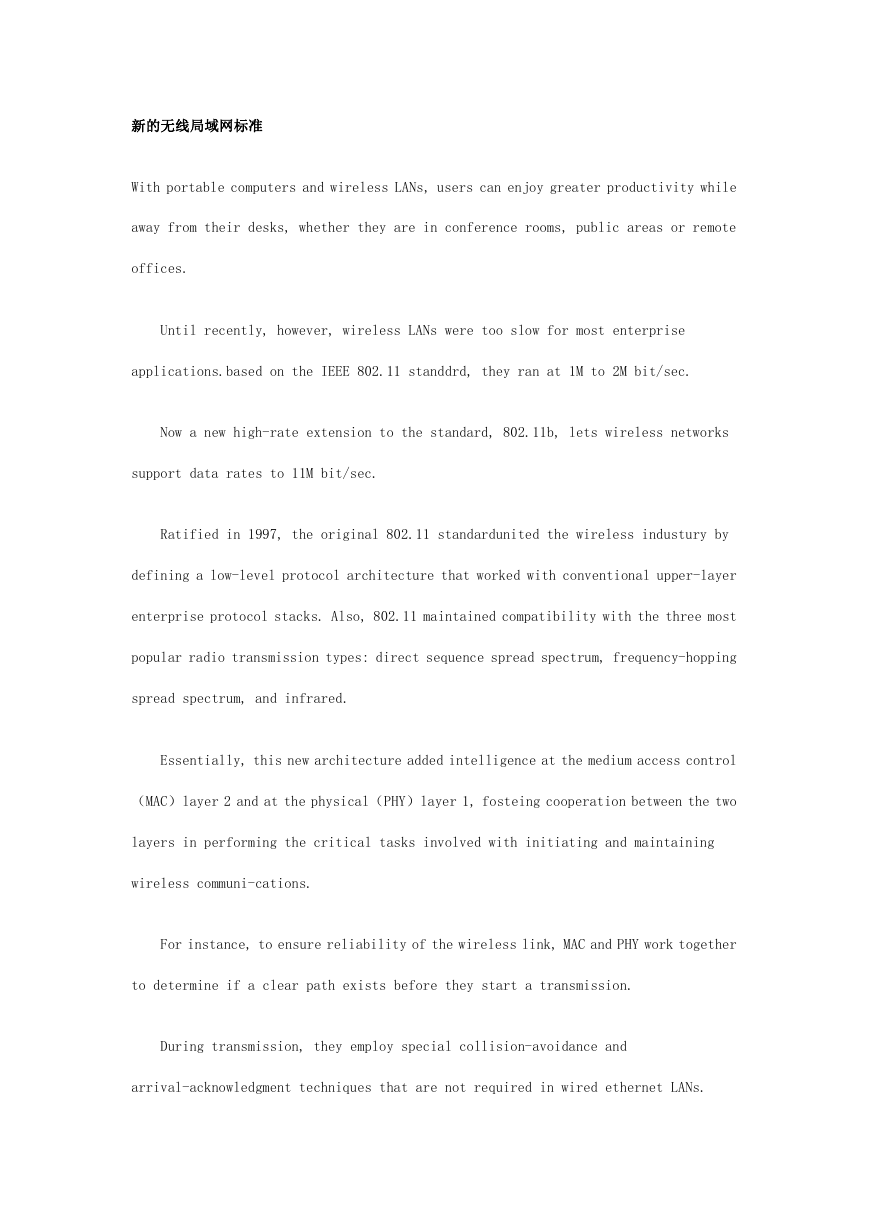
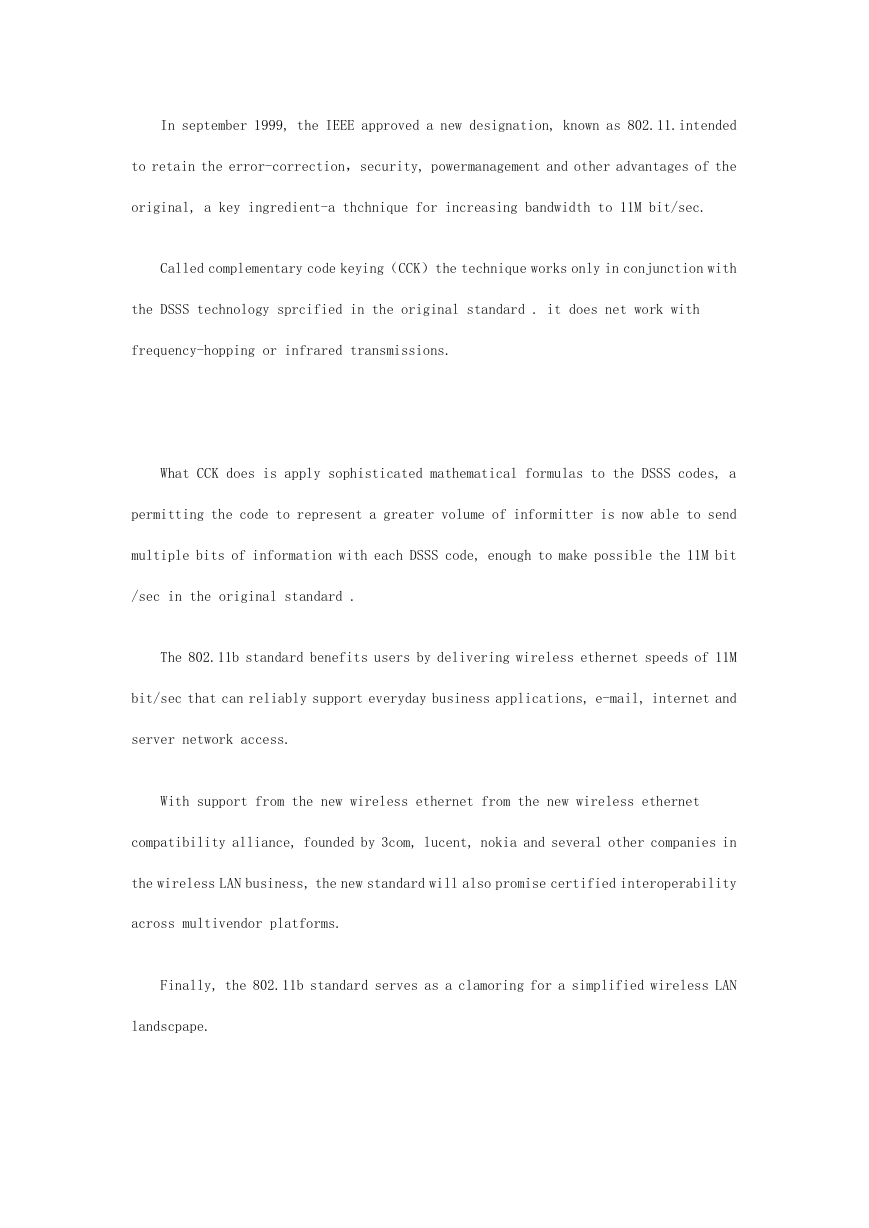
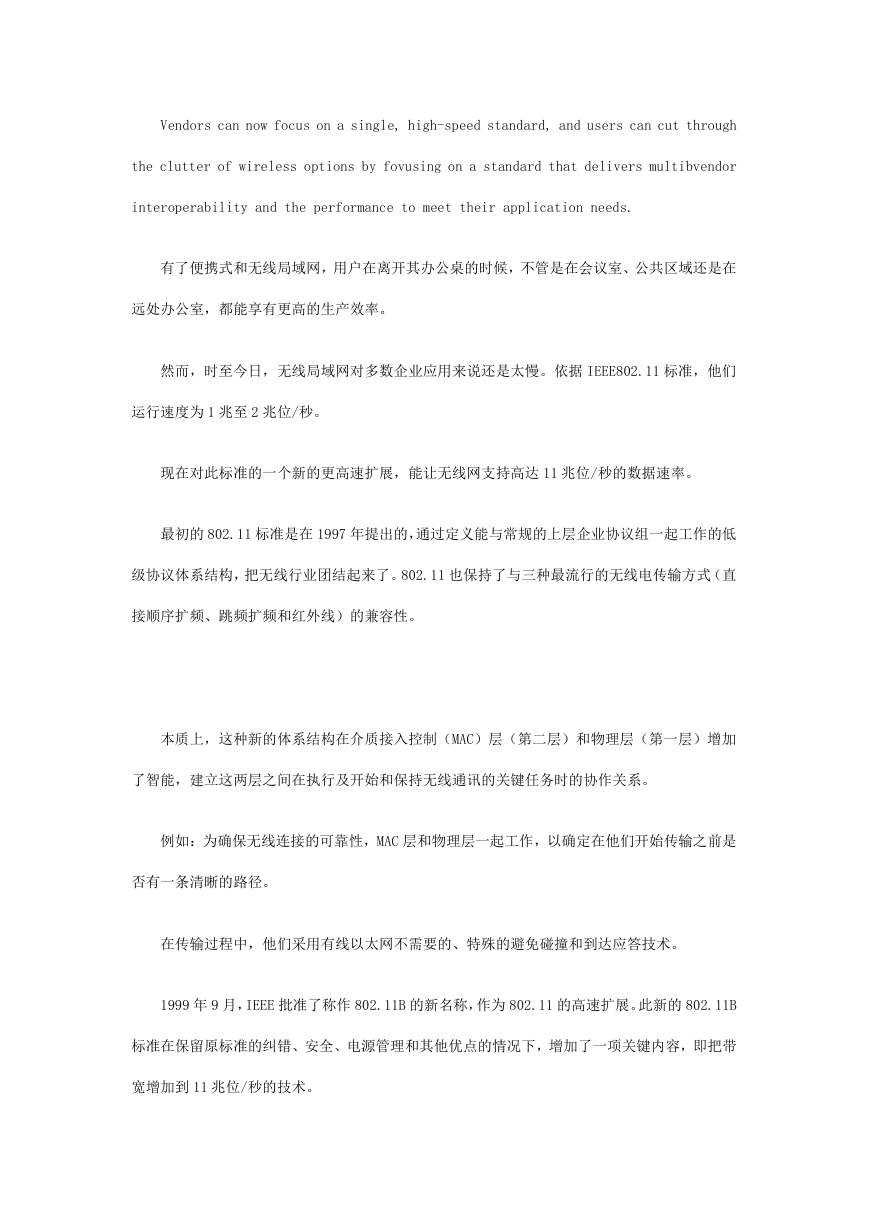

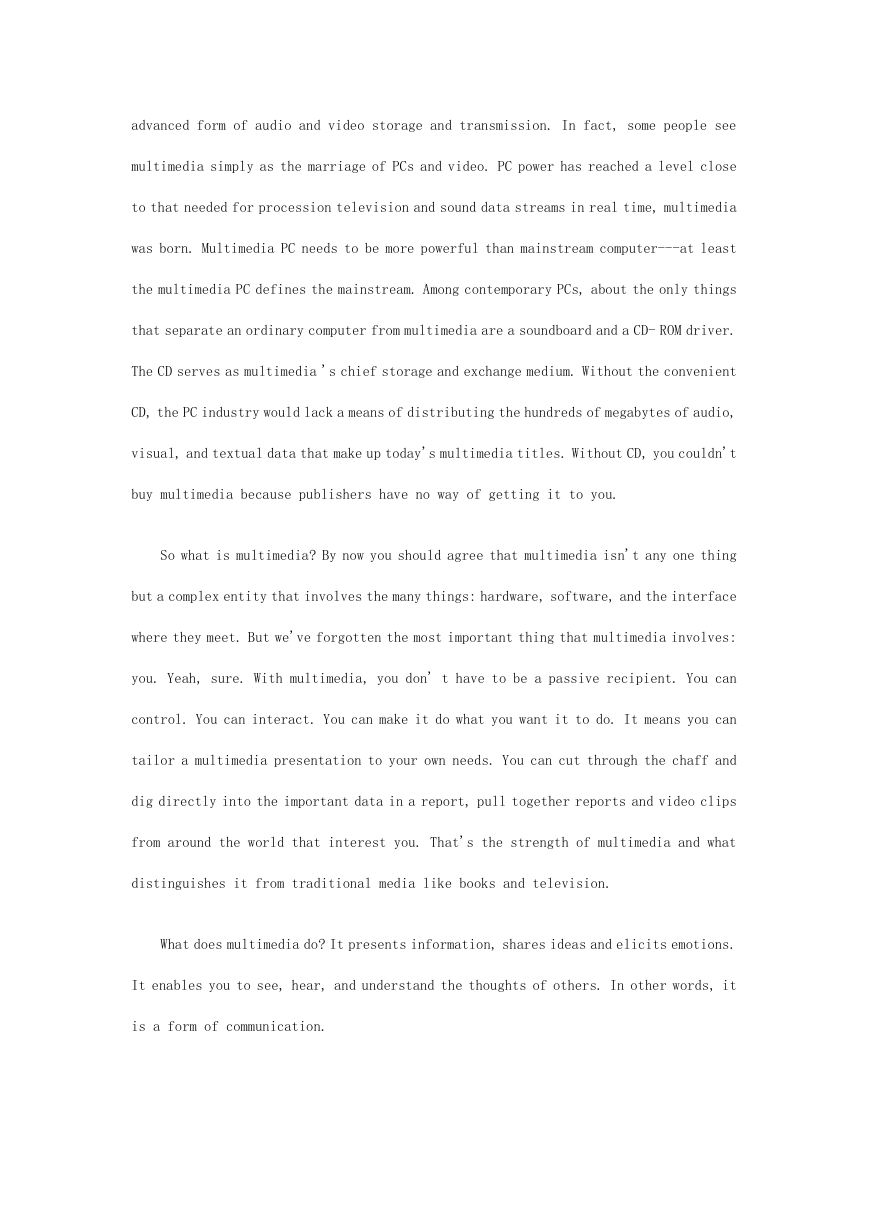
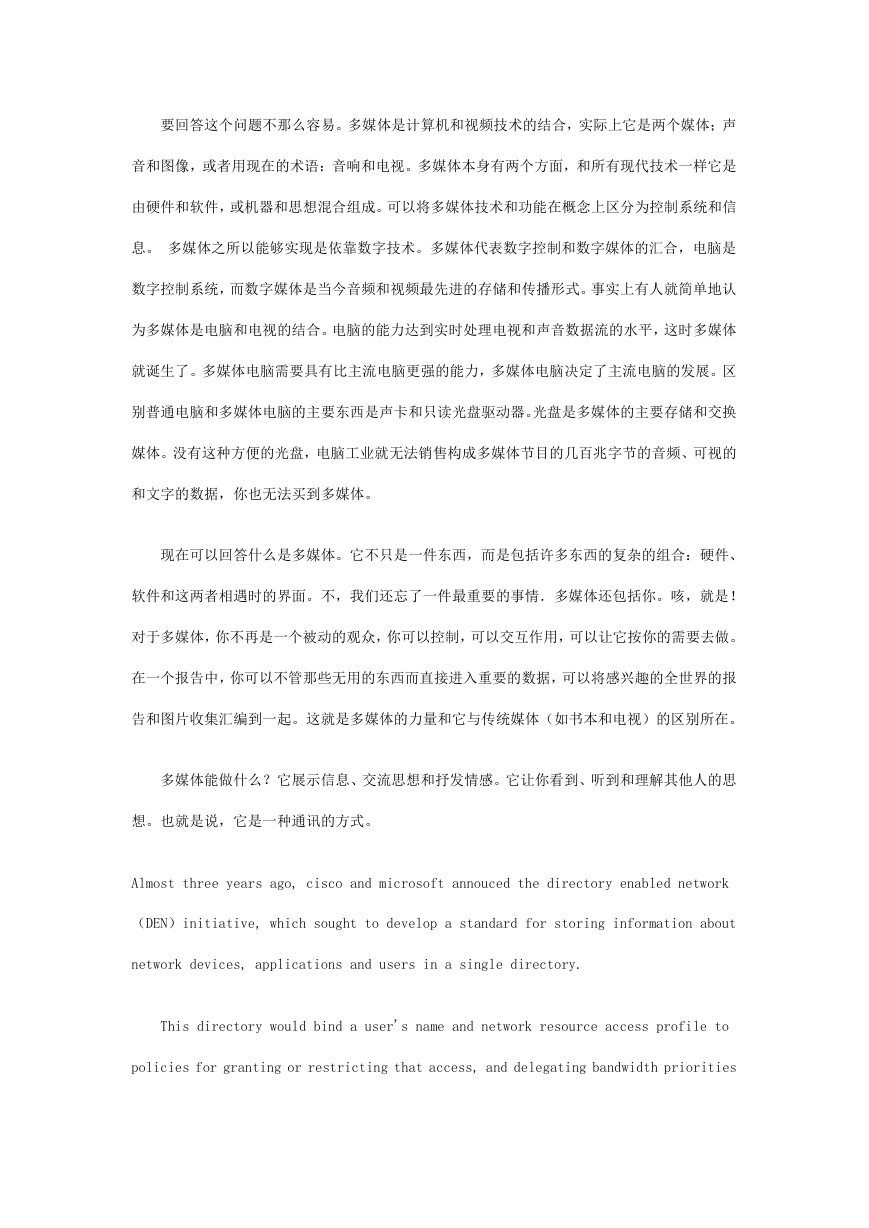
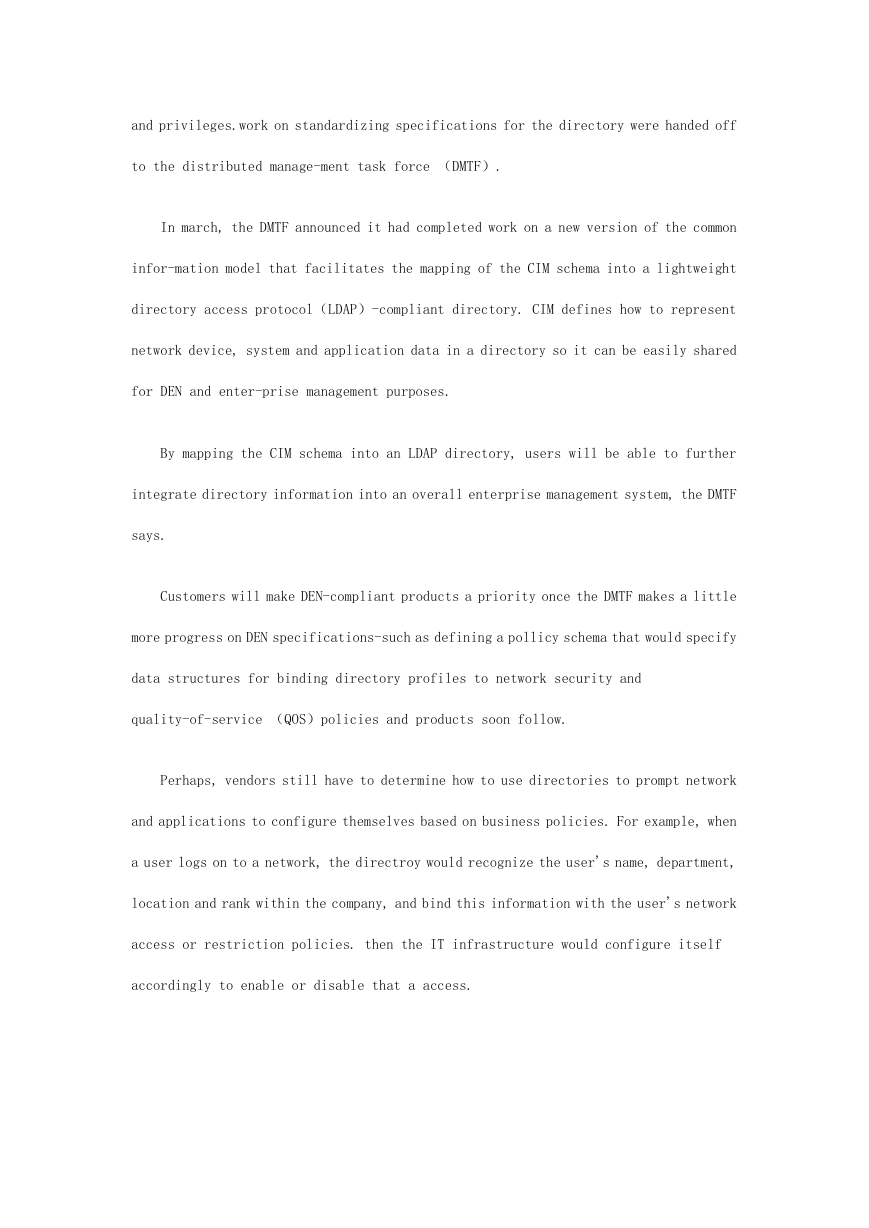
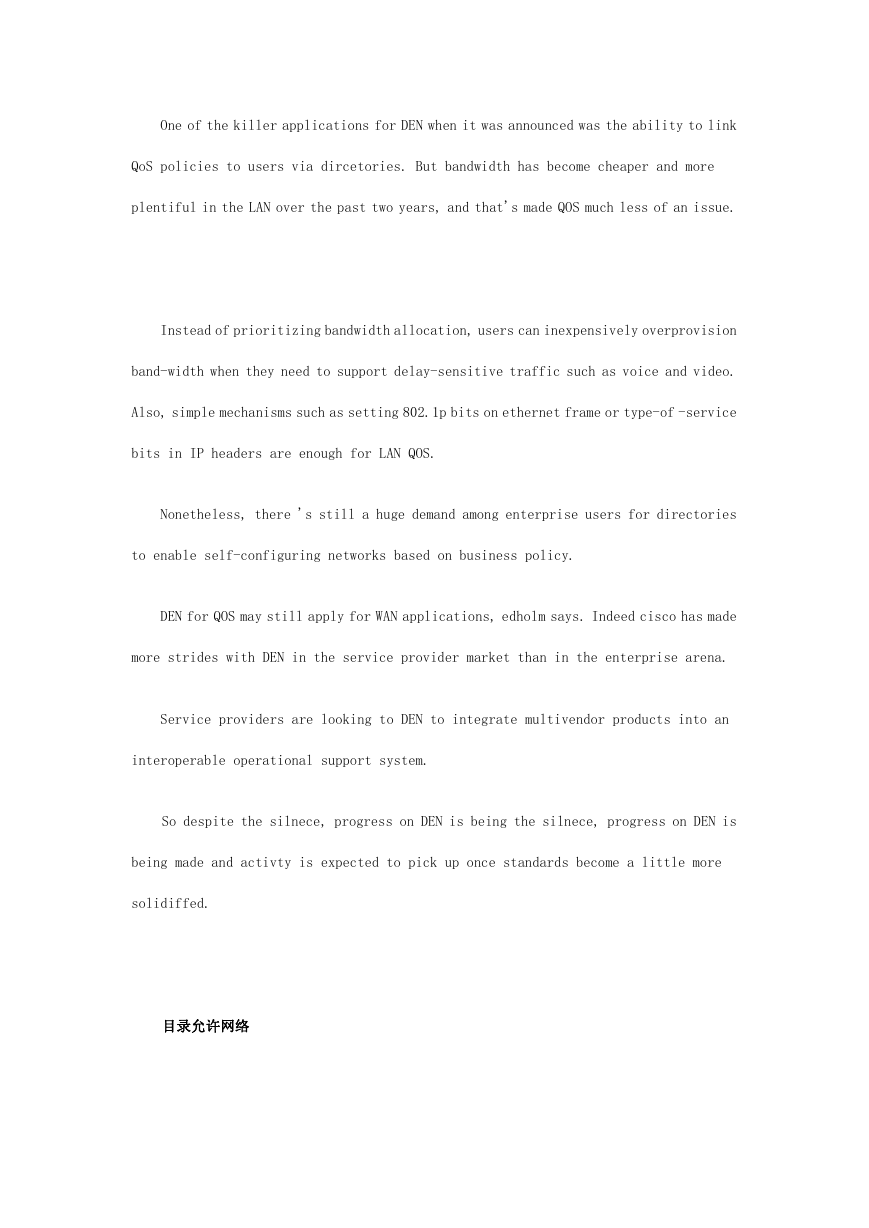








 2023年江西萍乡中考道德与法治真题及答案.doc
2023年江西萍乡中考道德与法治真题及答案.doc 2012年重庆南川中考生物真题及答案.doc
2012年重庆南川中考生物真题及答案.doc 2013年江西师范大学地理学综合及文艺理论基础考研真题.doc
2013年江西师范大学地理学综合及文艺理论基础考研真题.doc 2020年四川甘孜小升初语文真题及答案I卷.doc
2020年四川甘孜小升初语文真题及答案I卷.doc 2020年注册岩土工程师专业基础考试真题及答案.doc
2020年注册岩土工程师专业基础考试真题及答案.doc 2023-2024学年福建省厦门市九年级上学期数学月考试题及答案.doc
2023-2024学年福建省厦门市九年级上学期数学月考试题及答案.doc 2021-2022学年辽宁省沈阳市大东区九年级上学期语文期末试题及答案.doc
2021-2022学年辽宁省沈阳市大东区九年级上学期语文期末试题及答案.doc 2022-2023学年北京东城区初三第一学期物理期末试卷及答案.doc
2022-2023学年北京东城区初三第一学期物理期末试卷及答案.doc 2018上半年江西教师资格初中地理学科知识与教学能力真题及答案.doc
2018上半年江西教师资格初中地理学科知识与教学能力真题及答案.doc 2012年河北国家公务员申论考试真题及答案-省级.doc
2012年河北国家公务员申论考试真题及答案-省级.doc 2020-2021学年江苏省扬州市江都区邵樊片九年级上学期数学第一次质量检测试题及答案.doc
2020-2021学年江苏省扬州市江都区邵樊片九年级上学期数学第一次质量检测试题及答案.doc 2022下半年黑龙江教师资格证中学综合素质真题及答案.doc
2022下半年黑龙江教师资格证中学综合素质真题及答案.doc